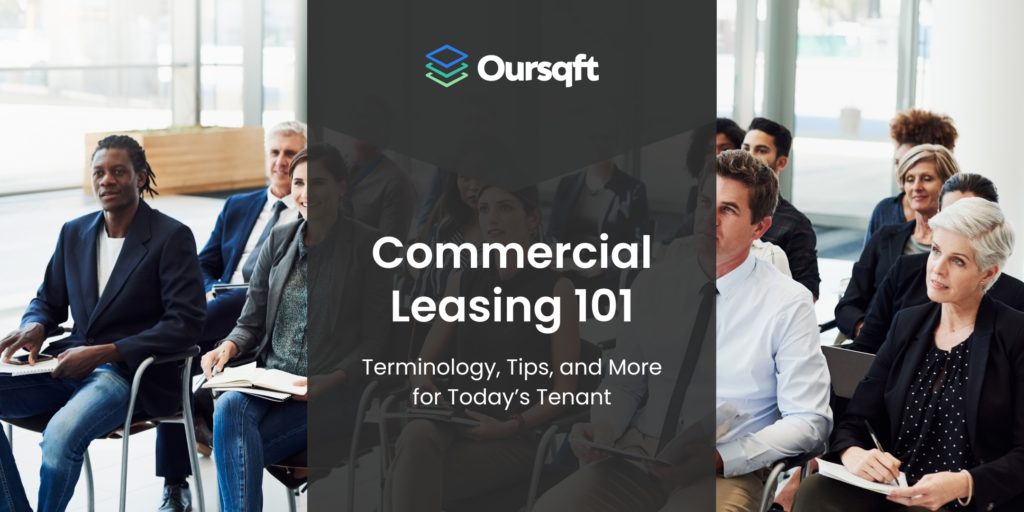Leasing office space is a significant decision for any business, and for tenants unfamiliar with the process, it can feel overwhelming. Understanding the terminology and key considerations can help tenants make informed decisions that will benefit their business in the long term. Whether you’re a startup looking for your first office or an established company seeking a new location, this guide will help you navigate the world of office leasing with confidence.
Key Terminology in Office Leasing
Before diving into the process, it’s essential to understand some key terms you’ll encounter in office leasing agreements:
- Rentable Square Footage (RSF): This includes the total square footage of the office space plus a portion of the building’s common areas (like lobbies, hallways, and restrooms). Tenants pay rent based on the RSF, even though not all of that space is for their exclusive use.
- Usable Square Footage (USF): This is the actual square footage of the space you occupy. It excludes common areas and is the space your business will be able to furnish and use.
- Base Rent: This is the core amount you will pay for the office space before any additional costs. It’s often quoted as an annual or monthly cost per square foot.
- Full-Service Lease: In a full-service lease, the rent covers all operating expenses, including utilities, janitorial services, and maintenance. This can simplify budgeting but often comes with a higher base rent.
- Triple Net Lease (NNN): A triple net lease separates rent and operating expenses. The tenant is responsible for paying their share of property taxes, insurance, and maintenance in addition to the base rent.
- Gross Lease: In a gross lease, the tenant pays a fixed rental amount, and the landlord covers most or all operating expenses, such as utilities, property taxes, and maintenance costs. This makes budgeting simpler for the tenant, as they know exactly what they are responsible for each month. However, gross leases often come with a higher base rent to compensate for the inclusion of these additional costs.
- Modified Gross Lease: A modified gross lease is a compromise between a gross lease and a triple net lease. In this type of lease, the tenant and landlord split operating expenses. For example, the tenant might pay base rent along with certain expenses like utilities, while the landlord covers taxes and maintenance. This offers a balance between cost predictability and responsibility for operating expenses.
- Common Area Maintenance (CAM): This refers to expenses related to maintaining common areas in the building. In many leases, tenants pay their proportionate share of CAM fees.
- Tenant Improvements (TI): Tenant improvements are custom alterations or renovations made to the office space to fit your needs. Sometimes the landlord will provide a TI allowance to cover part of these costs.
- Lease Term: The length of the lease agreement. Office leases typically range from 3 to 10 years. Shorter leases provide flexibility, while longer leases can offer stability and potential cost savings.
- Rent Escalation: Many leases include annual rent increases based on inflation or market conditions. These increases are usually built into the lease terms and should be considered when budgeting for the future.
- Option to Renew: Some leases include an option to extend the lease term at a pre-agreed rental rate. This can provide a tenant with flexibility if the location proves to be a good fit.
- Lease Guarantee: A lease guarantee is a legal commitment, often required by landlords, to ensure that rent and other obligations under the lease will be paid. This is particularly common for newer or smaller businesses with limited financial history. If the tenant defaults, the guarantor (often the business owner or a financially sound individual or entity) is legally required to fulfill the lease obligations.
- Guarantor: A guarantor is the individual or entity that provides a lease guarantee. For startups or businesses with no significant credit history, landlords may require a personal guarantee from the business owner or a third party. Guarantors take on financial liability for the lease if the tenant cannot meet their obligations, so it’s important to carefully consider the terms of any guarantee before signing.
- Security Deposit: Like residential leases, commercial leases typically require a security deposit, which is held by the landlord to cover any damages or unpaid rent. The amount of the deposit can vary, often based on the tenant’s creditworthiness and the length of the lease.
- Sublease: A sublease occurs when a tenant rents out all or a portion of their leased space to another tenant. This can be a useful option if the tenant no longer needs the entire space or if the tenant is relocating but still has time left on the lease. However, the original tenant remains responsible for the lease and rent payments, so it’s important to structure the sublease carefully.
Must-Knows for First-Time Tenants
Now that you’re familiar with some basic terminology, it’s important to understand the critical factors that will affect your decision when leasing office space. Here are a few essential things to keep in mind:
- Determine Your Space Needs
One of the first steps is figuring out how much space you actually need. Consider the number of employees, meeting rooms, storage, and common areas required for your business to operate smoothly. It’s better to slightly overestimate your needs than underestimate, as you don’t want to outgrow the space too quickly.
- Budget Beyond Base Rent
When calculating your budget, make sure to account for more than just the base rent. Operating expenses such as utilities, CAM fees, taxes, insurance, and any maintenance costs can add up. Additionally, factor in any potential rent escalations over the term of the lease.
- Lease Type Matters
Understand the difference between lease types, as they affect how much you pay and what is included. In a full-service lease, many of the costs are bundled into the rent, making budgeting easier. In a triple net lease (NNN), tenants must pay for additional expenses like property taxes, insurance, and maintenance, which can fluctuate year by year.
- Negotiate Tenant Improvements
When you’re moving into a new space, you may want to customize it to suit your business. Tenant improvement allowances are often negotiable, so don’t be afraid to ask the landlord to contribute to the cost of renovations. Landlords are often willing to work with tenants on this, especially for longer-term leases.
- Understand the Lease Term
How long do you plan to stay in the space? A shorter lease gives you flexibility but may come at a higher rent. Longer leases often allow for better rates, but you should make sure your business will thrive in that space for the duration of the lease.
- Plan for Growth
Consider your company’s growth when choosing an office space. If you expect to expand in the near future, look for spaces with room to grow or negotiate lease terms that allow for flexibility in case you need more space.
- Get Professional Help
It’s a good idea to seek help from a commercial real estate broker, especially if you’re new to the process. Brokers can help you find spaces that meet your needs and can negotiate terms in your favor. Additionally, working with a real estate attorney ensures that you understand the legal aspects of your lease agreement.
Conclusion
Educating yourself about office leasing is crucial to making the right decision for your business. Understanding key terms like base rent, tenant improvements, and lease types can empower you to make informed decisions that protect your company financially and operationally. Beyond the basics, it’s important to carefully consider your business’s unique needs and seek professional advice when necessary. With the right approach, leasing an office can become a strategic move that supports your business’s growth and success.



